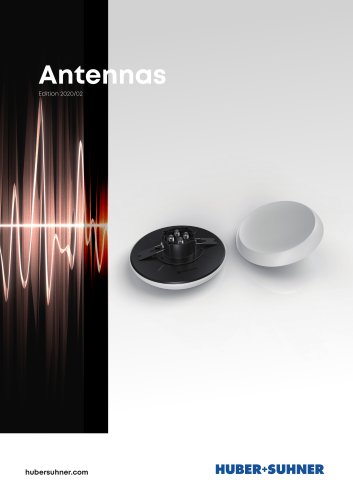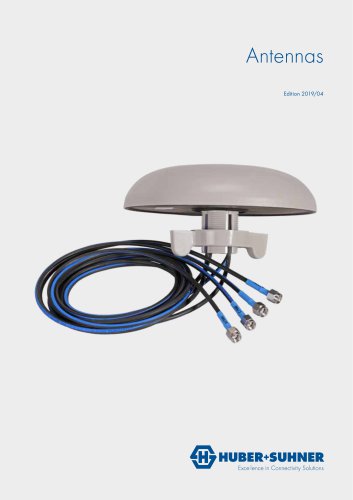
Katalogauszüge

Remote Radio Installation White paper
Katalog auf Seite 1 öffnen
Best practice guide: How to install remote radio systems 2 HUBER+SUHNER Wireless Infrastructure White paper
Katalog auf Seite 2 öffnen
The advantage of remote radio Systems 4 General aspects of RRH installation 5 Trends in the installation of remote radios 7 Installation methods for RRH's 9 1. Discretefeeders for Single RRHs (FTTA/PTTA) 10 2. Multi-riser cable with compact divider 11 3. Hybrid-riser cable with compact divider 1 3 4. Multi-riser cable with distribution boxes 15 5. Hybrid-riser cable with distribution box 16 6. Hybrid-riser cable with compact connector head 17 7. Single RRH hybrid feeder 18 Additional questions about fiber optics 20 The installation of remote radio Systems poses new challenges for mobile...
Katalog auf Seite 3 öffnen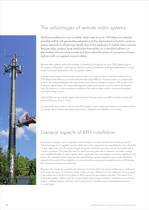
The advantages of remote radio systems Mobile broadband is now a reality. Data rates of up to 100 Mbps are already possible with fourth generation networks and the deployment of mobile communication networks is advancing rapidly due to the explosion in mobile data volumes. Remote radio systems have established themselves as a standard solution on the wireless infrastructure market and have taken the place of conventional base stations with corrugated coaxial cables. Remote radio systems reduce the energy consumed by the network by up to 30%, depending on the system configuration, and...
Katalog auf Seite 4 öffnen
Fiber optic System manufacturers of base stations offer factory-terminated cable assemblies with lengths of increments of typically 10min order to cover the various connection lengths. LC duplex connectors are used almost exclusively on the base Station side and are connected to so-called SFP modules (electro-optical transceivers) in protected areas inside the base Station. The RRHs are installed in an unprotected outdoor area and are exposed to rain, corrosion and extreme temperature fluctua- tions, which results in increased demands with regard to Connectivity. Here, primarily three...
Katalog auf Seite 5 öffnen
Power cable Copper cables are usually easier to install than fiber optic cables because there is no need to keep to minimum bend radiuses. Copper cables do not react as sensitively to lateral pressures or sharp edges and can also be terminated in the field for certain RRH models. On the base station side, the cooper cables are mostly stripped and clamped in screw terminals, although some system manufacturers also use factory-assembled connectors. In principal, there are three types of connection methods on the RRH side: • Factory-terminated connectors which connect the cable shielding...
Katalog auf Seite 6 öffnen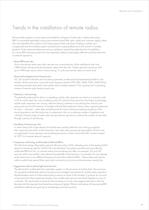
Remote radio installation Trends in the installation of remote radios Remote radio systems can be used and installed for all types of radio sites. Traditionally, every RRH is connected separately using a pre-connectorized fiber optic cable and a power supply cable. The main benefit of this solution is that every type of radio site (mast, building, rooftop, etc.) is supported and this enables system manufacturers to give preference to this solution in turnkey projects. At the same time there are various installation trends that make this kind of installation (i.e. every RRH receives power...
Katalog auf Seite 7 öffnen
• Efficient and future-oriented cable infrastructure: As a consequence of the data explosion, remote radios now have a service life of 3 to 5 years until an upgrade or a replacement becomes necessary. Many mobile radio operators are already running their second generation of RRHs, but they wish to continue using their cable infrastructure, which was expensive and complex to install. RRH installation systems that support several generations of active technology regardless of systems or manufacturers are gaining rising levels of acceptance on the market and have already established themselves...
Katalog auf Seite 8 öffnen
Remote radio installation Installation methods for RRHs The following sections explain all of the different methods for installing remote radio systems and examine the advantages and disadvantages in both technical and commercial terms. The installation methods outlined are all used in practice and can be customized to reflect the specific requirements of the network operator when setting up networks. The sequence of installation solutions is sorted by global distribution and market acceptance. That means that the single-cable solution has been the one most frequently installed worldwide,...
Katalog auf Seite 9 öffnen
1. Discrete feeders for single RRHs (FTTA/PTTA) Discrete cables (FTTA/ PTTA) • Default solution of system vendors • Vendor specific cables and connectors • Not scalable • Not future proof In a typical 3-sector base station a total of 6 cables are installed. These are mounted at short intervals of 1 m to 1.5 m with cable clamps. Experience in installation shows that the laying of cables is by far the most time-consuming part of the entire installation. That makes this method, particularly over extended distances (> 50 m) and with more than 3 remote radios, expensive and inefficient. In...
Katalog auf Seite 10 öffnen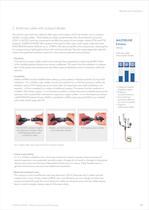
Remote radio installation 2. Multi-riser cable with compact divider This solution uses multi-riser cables for fiber optics and copper, which are «broken out» in compact dividers in single cables. These break-out cables are terminated with robust external connectors (ODC or Q-ODC) and are connected to the RRHs by means of short jumper cables (FTTA and PTTA jumpers). HUBER+SUHNER offers systems of this type for fiber optics and copper under the name MASTERLINE Extreme (MLE) for up to 12 RRHs. The obvious benefit is the compactness, meaning that it is a space-saving, lightweight solution with...
Katalog auf Seite 11 öffnen
• Reduced installation costs: The length of time required for installation is a major cost factor. The system can be delivered as a pre-installed «plug-and-play» solution and can be connected directly with the active equipment. In addition, the multi-riser cables are more rigid than individual cables due to their greater diameter, meaning that the securing clips can be installed at intervals of between 1.5 and 2 meters. Empirical data indicates that cable installation times can be reduced by between a third and half (compared to discrete cables). In a typical installation routine, this...
Katalog auf Seite 12 öffnenAlle Kataloge und technischen Broschüren von HUBER+SUHNER
-
RADOX® Coil winding industry
64 Seiten
-
Train to ground
16 Seiten
-
Railway products
200 Seiten
-
Railway connectivity
24 Seiten
-
Passive Components
36 Seiten
-
FO LC Portfolio
24 Seiten
-
Connectors accessories
13 Seiten
-
Cabling Systems
64 Seiten
-
Fiberoptik - LC Portfolio
24 Seiten
-
Produkte für die Bahn
156 Seiten
-
Fiberoptik - FC Sortiment
4 Seiten
-
RADOX - Fiberoptikkabel
2 Seiten
-
RF - Guide
159 Seiten
-
QMA - Verbinder
16 Seiten
-
MMPX - Verbinder
24 Seiten
-
Fiberoptik - OptiBox 4i
2 Seiten
-
Fiberoptik - SC Portfolio
8 Seiten
-
RADOX - RAILCAT CAT7
2 Seiten
-
Medical
20 Seiten
-
Automation Maschinenanlagen
20 Seiten
-
Wickelgüterindustrie RADOX
68 Seiten
-
SENCITY® Road Antenna
2 Seiten
-
SENCITY® Road MULTI Antenna
2 Seiten
-
SENCITY® Tram MULTI Antenna
2 Seiten
-
Antennas edition 2020
109 Seiten
-
Automotive products
72 Seiten
-
RF Connectors General Catalogue
573 Seiten
-
Fiber Optics MTP® assemblies
34 Seiten
-
Broadcast Solutions overview
8 Seiten
-
WHITE PAPER
7 Seiten
-
Fiber management Systems
40 Seiten
-
Data center solutions
238 Seiten
-
Connected Mobility
24 Seiten
-
Communication based train control
12 Seiten
-
Microwave cable assemblies
194 Seiten
-
RF cables
72 Seiten
-
Fiber Optic Cables
178 Seiten
-
Antennas edition 2019
105 Seiten
-
FO components
11 Seiten
-
Lightning protection
206 Seiten
-
RF components
44 Seiten
-
Space
140 Seiten
-
Railway products
208 Seiten
-
Aviation
28 Seiten
-
4.3-10 coaxial connector
20 Seiten
-
SENCITY®OMNI-S MIMO
2 Seiten
-
Network-Cubes
8 Seiten
-
Automotive Innovations
12 Seiten
-
Defense
146 Seiten
-
FO LISA
202 Seiten
-
FO equipment and products for LAS
152 Seiten
-
Enclosures and wall outlets
36 Seiten
-
DC solutions North America
208 Seiten
-
Railway cable systems - Overview
16 Seiten
-
Airfield Lighting
4 Seiten
-
19"fiber panels and modules
40 Seiten
-
Access network and FTTx solutions
84 Seiten
-
Wires & Cables
156 Seiten
-
19" fiber panels and modules
40 Seiten
-
Milcat 7
2 Seiten
-
VITA 67
2 Seiten
-
Microbend L
2 Seiten
-
Solutions for Small Cells / DAS
156 Seiten
-
FO connectors for harsh environment
72 Seiten
-
FO Cabling Systems
64 Seiten
-
FO Cables
160 Seiten
-
Automotive products
68 Seiten
-
Air traffic control
28 Seiten
-
Solutions for Defense applications
146 Seiten
-
Standard Fiber optic Assemblies
72 Seiten
-
RADOX® Milcat 7
2 Seiten
-
Resistive components
36 Seiten
-
Lightning protection
200 Seiten
-
High Density Solutions
72 Seiten
-
Board to Board connections
32 Seiten
-
Aviation
28 Seiten
-
FO tools equipment
10 Seiten
-
Feeder installation training
60 Seiten
-
DC Segment Transportation
12 Seiten
-
DC Segment Healthcare
12 Seiten
-
DC Segment Finance
12 Seiten
-
DC Segment Colocation
12 Seiten
-
Coaxial Connectors 4.3-10
4 Seiten
-
Test+Measurement Guide
32 Seiten
-
RF Connectors
478 Seiten
-
Fiber optic - FSMA portfolio
4 Seiten
-
RF cable - SPUMA 400
4 Seiten
-
Lightning and EMP protection
12 Seiten
-
Series SMA - Coaxial Connectors
40 Seiten
-
RF - Product portfolio
28 Seiten
-
Passive intermodulation
12 Seiten
-
Fiber Optic - CLIK!
12 Seiten
-
Space-SUCOFLEX TVAC
12 Seiten
-
Space-SUCOFLEX 300
24 Seiten
-
Multiport Solutions
12 Seiten
-
Communication on board
2 Seiten
-
Rail CBTC
12 Seiten
Archivierte Kataloge
-
Power Sub-Miniature PSM
4 Seiten































